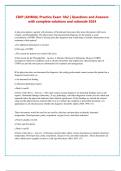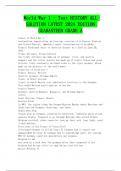CDIP (AHMIA) Practice Exam 1&2 | Questions and Answers
with complete solutions and rationale 2024
A physician admits a patient with shortness of breath and chest pain, then treats the patient with Lasix,
oxygen, and Theophylline. The physician's final documented diagnosis for the patient is acute
exacerbation of COPD. What is missing from this diagnosis that would make it reliable information in the
treatment of this patient?
a.No additional information is needed.
b.The type of COPD
c.The reason the patient was treated with Lasix
d.The reason for the Theophylline - Answer- b Chronic Obstructive Pulmonary Disease (COPD)
encompasses different conditions such as chronic bronchitis and emphysema. Specifying the type of
COPD can provide more precise information for treatment and management.
If the physician does not document the diagnosis, the coding professional cannot assume the patient has a
diagnosis based solely on
a.An abnormal lab finding
b.Abnormal pathology reports
c.Both A and B
d.None of the above - Answer- c The coder cannot assume diagnoses on abnormal findings such as lab
reports. Abnormal findings (laboratory, X-ray, pathologic, and other diagnostic results) are not coded and
reported unless the physician indicates their clinical significance. If the findings are outside the normal
range and the physician has ordered other tests to evaluate the condition or prescribed treatment, it is
appropriate to ask the physician whether the diagnosis should be added (AHA 1990, 15).
These documents would be used for are used by clinicians and providers to identify abnormal
temperature, blood pressure, pulse, respiration, oxygen levels, and other indicators.
a.Nurses' graphic records
b.Vital sign flowsheets
c.Both A and B
d.None of the above - Answer- c Clinicians and providers utilize various documents to identify abnormal
temperature, blood pressure, pulse, respiration, oxygen levels, and other indicators. These documents are
often called nurses' graphic records or vital sign flowsheets (Hess 2015, 43).
,The American Hospital Association (AHA), the American Health Information Management Association
(AHIMA), Center for Medicare and Medicaid Services (CMS), and National Center for Healthcare
Statistics (NCHS) are all
a.Cooperating parties
b.Governing bodies
c.Coding associations
d.Work independently to develop coding guidelines - Answer- a The American Hospital Association
(AHA), the American Health Information Management Association (AHIMA), Center for Medicare and
Medicaid Services (CMS), and National Center for Health Statistics (NCHS) are all cooperating parties
that developed and approved ICD-10-CM/PCS (ICD-10-CM Official Guidelines for Coding and
Reporting 2016a, 1).
CDI program data includes: - Answer- 1. All cases that were reviewed
2. Number of cases with queries
3. Nature of the query
4. Physician response to the query
Queries should only be asked: - Answer- 1. If there is clinical evidence that the documentation is
imcomplete or does not meet one of the seven criteria for high-quality clinical documentation.
2. By an individual with solid clinical knowledge.
3. In an open-ended manner (no yes or no questions)
4. In a nonleading manner.
5. To the individual whose documentaion is in question or who is responible for interpreting test results or
other data in the patient's record.
Query process and procedure should address: - Answer- 1. When queries will be asked.
2. Who will ask queries and to whom queries will be asked.
3. The hospital's responsibility in supporting the quering process.
4. The physician's responsibility in responding to queries.
5. Acceptable ways to responding to queries.
Examples of when a query is required may include: - Answer- 1. Documentation of reportable conditions
or procedures is conflicting, ambigious, or is otherwise incomplete.
,2. Abnormal diagnostic test results indicate the possible addition of a secondary diagnosis or higher
specificity of an already documented condition.
3. The patient is receiving treatment for a condition that has not been documented.
4. Abnormal operative or procedureal findings are not documented.
5. It is unclear as to whether a condition was ruled out.
6. The pricipal diagnosis is not clearly identified.
A patient was admitted with HIV and pneumocystic carini. The patient should have a principal diagnosis
in ICD-10 of:
a.AIDS
b.Asymptomatic HIV
c.Pneumonia
d.Not enough information - Answer- a If a patient is admitted for an HIV-related condition, the principal
diagnosis should be B20, Human immunodeficiency virus [HIV] disease followed by additional diagnosis
codes for all reported HIV-related conditions (ICD-10-CM Official Guidelines for Coding and Reporting
2016a, 17).
APR-DRGs have levels (subclasses) of severity entitled:
a.Excessive, Major, Moderate, Minor
b.Extreme, Major, Moderate, Minor
c.Extreme, Major, Moderate, Minimal
d.Excessive, Major - Answer- b The APR-DRG system is distributed into levels (subclasses) similar to
MS-DRGs. These levels are entitled Extreme, Major, Moderate, Minor (Hess 2015, 48)
During an outpatient procedure for removal of a bladder cyst, the urologist accidentally tore the urethral
sphincter requiring an observation stay. This should be assigned as the principal diagnosis:
a.The reason for the outpatient surgery
b.The reason for admission
c.Either the reason for the outpatient surgery or the reason for admission
d.None of the above - Answer- a When a patient presents for outpatient surgery and develops
complications requiring admission to observation, code the reason for the surgery as the first reported
diagnosis (reason for the encounter), followed by codes for the complications as secondary diagnoses
(ICD-10-CM Official Guidelines for Coding and Reporting 2016a, 103).
, In 1990, 3M created which DRG system that several states use for Medicaid reimbursement and is also
used by facilities to analyze some portion of the data for Medicare Quality Indicators. What is this system
called?
a.MS-DRGs
b.AP-DRGs
c.APR-DRGs
d.CPT-DRGs - Answer- c In 1990, 3M created APR-DRGs, which several states use for Medicaid
reimbursement. APR-DRGs are used by facilities to analyze some portion of the data for Medicare
Quality Indicators (Hess 2015, 48)
A patient was admitted to an acute care facility with a temperature of 102 and atrial fibrillation. The chest
x-ray reveals pneumonia with subsequent documentation by the physician of pneumonia in the progress
notes and discharge summary. The patient was treated with oral antiarrhythmia medications and IV
antibiotics. What is the principal diagnosis?
a.Pneumonia
b.Arrhythmia
c.Atrial fibrillation
d.Both a and c - Answer- a The patient presented with clinical signs of Pneumonia along with treatment.
The atrial fibrillation was a chronic condition that can be reported additionally (CMS 2016b).
The Cooperating Parties, which develop and approve ICD-10, include:
a.American Hospital Association (AHA) and American Health Information Management Association
(AHIMA)
b.American Hospital Association (AHA), American Health Information Management Association
(AHIMA), and Centers for Disease Control (CDC)
c.American Hospital Association (AHA), American Health Information Management Association
(AHIMA), and Centers for Medicare and Medicaid Services (CMS), and National Center for Health
Statistics (NCHS)
d.American Hospital Association (AHA), American Health Information Management Association
(AHIMA), and the World Health Organization (WHO) - Answer- c The cooperating parties developed
and approved ICD-10-CM/PCS and include (4) organizations American Hospital Association (AHA),
American Health Information Management Association (AHIMA), and Centers for Medicare and
Medicaid Services (CMS), and National Center for Health Statistics (NCHS) (CMS 2016c).





